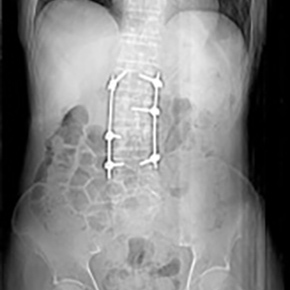Keywords
Coxiella burnetii, Q fever, Spondylodiscitis
Abstract
Coxiella burnetii causes Q fever, which is found worldwide and can be acute or chronic. This case report describes a 72-year-old man whose bilateral lower limb pain revealed a paravertebral abscess at L2–L3 due to Q fever spondylodiscitis. Surgical drainage of the abscess was performed and medical treatment is ongoing.
Q fever is endemic in Portugal and transmitted by inhalation of aerosols containing spores from infected animals (cattle, goats and sheep) or by ingesting cottage cheese or unpasteurized milk. It has an incubation period of 2–3 weeks and 60% of patients are asymptomatic with only 2% needing hospitalization. Primary infection can manifest in any organ and most cases are self-limiting (self-limited febrile illness, atypical pneumonia or acute hepatitis). Less than 1% of cases evolve to chronic disease, presenting as osteomyelitis or endocarditis.
Chronic disease poses a diagnostic challenge and spondylodiscitis has an insidious evolution. Diagnosis requires microbiological and clinical confirmation. Serological and polymerase chain reaction tests are used for diagnosis. <br/>
Acute disease is usually treated with doxycycline for 3 weeks to avoid evolution to chronic disease. Chronic disease requires 18–24 months of doxycycline with hydroxychloroquine. Acute disease can recur so follow-up is essential as chronic Q fever can result in morbidity and mortality. In Portugal Q fever is a notifiable disease due to the epidemiological risk.
References











